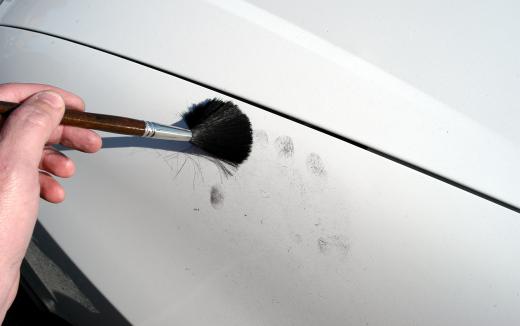What is Fingerprint Classification?
 Mary McMahon
Mary McMahon
Fingerprint classification is the division of fingerprints into rough categories to make them easier to match with existing records in a system. This was critical in an era when investigators had to rely on paper files for fingerprint matching and needed a way for quickly narrowing down the options when comparing fingerprints from a scene with those on file. Today, electronic systems make comparisons easier and more reliable, but fingerprint classification can still be important for investigators.
Fingerprints occur when people leave behind skin oils and other residue after handling something. The friction ridges on the fingers are very distinctive, and the possibility of having the same pattern as another living person is very low. Even identical twins have different fingerprints. Researchers who study the patterns of friction ridges on the fingertips have identified several broad classes on the basis of the shapes they find.

One is the whorl, where an isolated dot appears in the middle of the fingerprint. This is a relatively rare type of fingerprint pattern. Arches are another example, including both regular and tented arches. Finally, people can have what is known as a loop pattern, where the tissue loops around to the left or right. An investigator looking at a set of fingerprints can quickly determine if they are arches, loops, or whorls.

The fingerprint classification allows for further categorization within each broad category. Investigators can determine the direction of patterns in the friction ridges and may take note of any special characteristics. Sometimes people may have heavily scarred fingers, leading to destruction of the original fingerprint pattern and the need to match marks left by scars. Fingerprint classification systems may assign numerical values to different types of patterns, allowing people to come up with numeric codes to help them quickly find similar fingerprints on file.

Students learning about the history of fingerprinting may do an exercise where they take fingerprints from each other and learn about the fingerprint classification system. They can study comparison samples in textbooks to learn more about the different patterns as well as the subtypes. While investigators today rely primarily on computer systems to make matches, they can also match fingerprints by hand, looking for the distinctive features of the pattern to determine whether a sample from a crime scene matches a reference kept on file, such as prints from a known criminal or suspect. A casual review can also help an investigator rule someone out; if fingerprints from a crime scene are arched and a suspect has whorls, for example, the investigator knows her fingerprints won't match those from the scene.
AS FEATURED ON:
AS FEATURED ON:













Discuss this Article
Post your comments